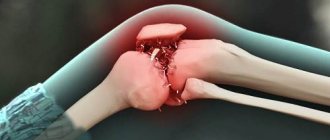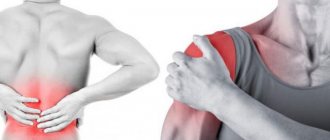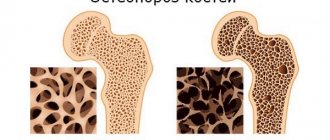There is a famous saying: “A person’s age is determined by how flexible his spine is. Unfortunately, the conditions of modern life and many negative factors are not favorable for maintaining the body in a healthy state. Therefore, diseases of the musculoskeletal system are being diagnosed more and more often, including in young people. The musculoskeletal system is a complex system consisting of a large number of functionally different parts - bone skeleton, skeletal muscles, joints, ligaments. All this together performs supporting tasks, provides the possibility of movement, and also provides mechanical protection for internal organs. Any of these components can be damaged.
Basic and most common diseases
It is quite difficult to list all diseases of the musculoskeletal system, because their list is quite long. But, according to the characteristics of their development, diseases can be divided into several groups: • inflammatory in nature. The cause is usually an infection or injury that causes inflammation. This category includes arthritis, bursitis, myositis, osteomyelitis, periarthritis, radiculitis and others; • degenerative in nature. Such diseases are accompanied by a violation of the structure and functionality of individual elements. These include arthrosis, ankylosis, osteochondrosis, spondyloarthrosis, etc.; • various types of deformities: scoliosis, kyphosis, flat feet. You should also know that diseases of the musculoskeletal system are accompanied by damage or impairment of the functionality of its various components: • bone tissue; • muscles; • joints. Depending on this, the treatment tactics and its effectiveness will differ.
Diagnostic and treatment methods
For any disease, it is necessary to start with diagnosis and diagnosis. A rheumatologist, orthopedist, or traumatologist is involved in identifying problems with the musculoskeletal system.
First of all, a patient survey is conducted, where preliminary data are collected on the nature of pain in the areas of the musculoskeletal system and the duration of the disease.
A number of additional studies and laboratory tests are added to the oral interview. Among them:
- assessment of range of motion and intensity of pain syndromes;
- visual inspection;
- palpation of damaged areas;
- blood analysis;
- radiography;
- Ultrasound, tomography, etc.
Once the diagnosis is made, treatment is prescribed. In case of injuries to the musculoskeletal system, the patient is instructed to remain calm and not disturb the damaged ligaments. Additionally, the application of cold compresses, ointments, and gels is prescribed.
Treatment of other injuries combines a whole range of measures. It can be:
- massages;
- physiotherapy;
- sanatorium treatment;
- medications (anti-inflammatory, painkillers, hormonal, etc.)
- vitamin complexes.
In some cases, surgical intervention is required to treat injuries and other types of damage to the musculoskeletal system.
Causes of development of diseases of the musculoskeletal system
If we talk about the reasons that can provoke the appearance of the diseases in question, we can highlight several main negative factors: • infections. They provoke the development of inflammatory processes in joints and muscles; • injuries. Against their background, diseases of the musculoskeletal system develop very often and can occur immediately or after a certain period of time, even after several years; • congenital pathologies. Here, a child from birth has certain disorders caused by genetic factors or developmental problems when he was still at the embryonic stage; • metabolic disease. Often this factor becomes the cause of degenerative changes; • disruption of the immune system. It can also cause diseases of the musculoskeletal system; • complications after surgery; • excessive physical activity without taking proper time to rest. Knowing the causes of disease development, we can immediately identify the main preventive measures. They will consist of the following points: • adherence to a regime of physical activity and rest; • maintaining an active lifestyle; • good nutrition; • timely treatment of emerging diseases; • elimination of bad habits. Such simple preventive measures will help reduce the likelihood of developing diseases that cause significant discomfort and require immediate and long-term treatment.
Muscle structure
Each skeletal muscle is an active organ of movement, built from many tissues, the main of which is striated muscle tissue. In addition, the muscle includes loose and dense connective tissue, blood vessels and nerves.
The functional significance of muscle as an organ lies in its ability to contract and change its size.
Symptoms of musculoskeletal diseases
Diagnosis in this case does not cause difficulties. The symptoms are pronounced enough that they cannot go unnoticed. In the initial stages they are weaker, but as the disease deepens, the symptoms will also intensify. The main symptoms of diseases of the musculoskeletal system include: • pain. They are localized in the area of affected tissues and can be periodic or permanent. The pain can be sharp and aching. At first, they can be stopped with analgesics, but over time, the drugs stop giving the desired effect; • limitation of mobility. Typically, this symptom is observed when the joints are damaged, indicating a fairly serious stage of the disease; • swelling. May occur with problems with muscles or joints; • increase in local body temperature. Indicates the presence of an inflammatory process; • increased fatigue. It usually accompanies scoliosis and flat feet; • crunching during movements. If any of the listed signs appear, you should immediately seek help from a doctor.
Treatment of movement organs
A doctor who treats diseases of the musculoskeletal system is an orthopedist-traumatologist. He clarifies the diagnosis. Inspects and palpates the affected area and checks range of motion. Prescribes x-rays, CT, MRI, ultrasound, and sends them to the laboratory for tests. An accurate diagnosis is the initial key to successful treatment. In the acute phase, painkillers, anti-inflammatory, and hormonal drugs are prescribed. The diseased part is immobilized and spared, using traction devices. Sometimes it is impossible to do without surgery: if you need to sew torn ligaments, restore the integrity of the bone, or remove a tumor.
Another approach in the recovery stage: you need to restore lost functions to the limbs as much as possible. This is done gradually, therapeutic exercises, massage are prescribed, and appropriate methods of physiotherapy are applied. The rehabilitation period can take a long time. But this is the only way to restore the musculoskeletal system without harming your health.
Features of treatment
Treatment of diseases of the musculoskeletal system is usually carried out comprehensively. The treatment regimen depends on the type and stage of the disease. Doctors may prescribe a combination of the following: 1. Anti-inflammatory drugs. They help relieve inflammation, relieve pain, get rid of swelling and discomfort during movement and at rest. 2. Chondroprotectors. Used as part of complex therapy to restore joint health. They have a beneficial effect on cartilage tissue and help restore the composition of synovial fluid. 3. Antibacterial drugs. They are relevant in the presence of an inflammatory process of an infectious nature, and are often used in the treatment of diseases of the musculoskeletal system. 4. Therapeutic exercises. They are prescribed not only to children, but also to adults, they help get rid of numerous disorders and recover faster after therapy. The exercises are performed under the supervision of experienced specialists, and after a certain time, with their permission, exercise therapy can be done at home. 5. Physiotherapy. Also used in the complex treatment of diseases of the musculoskeletal system, used to speed up therapy and increase its effectiveness. 6. Vitamin and mineral complexes. Used for general strengthening of the body, joints and bone tissue. They also improve the general condition of a person and strengthen the immune system. 7. Massage. Very often prescribed in combination with exercise therapy and physiotherapeutic procedures. It is used in the treatment of children and adult patients. Massage should only be performed by a qualified specialist. Then you will be able to get the maximum positive effect and avoid complications. Surgical intervention becomes relevant only in cases where conservative treatment of diseases of the musculoskeletal system has not given the desired effect. As a rehabilitation therapy after surgery, it is recommended to undergo sanatorium-resort treatment. It is carried out in specialized complexes located in ecologically clean regions of the country.
Prevalence of the problem
Data from the recent Global Burden of Disease (GBD) study indicate that approximately 1.71 billion people worldwide suffer from musculoskeletal disorders and diseases (1). Although the prevalence of musculoskeletal diseases varies by age and diagnosis, they affect people of all ages throughout the world. Populations in high-income countries (441 million people) are most affected by such diseases, followed by those in the Western Pacific Region (427 million people) and the South-East Asia Region (369 million people). Musculoskeletal disorders and diseases are also the leading contributors to disability worldwide, accounting for approximately 149 million years of life lived with a disability, representing 17% of all years lived with a disability from any cause globally.
Lumbago accounts for the majority of the total burden of musculoskeletal disorders and diseases. Other factors contributing to this burden include fractures (436 million people worldwide), osteoarthritis (343 million people), other injuries (305 million people), cervicalgia (222 million people), amputations (175 million people) and rheumatoid disease. arthritis (14 million people) (1).
Although the prevalence of musculoskeletal disorders and diseases increases with age, they also affect younger people, often during the years of peak economic activity. Lumbago, for example, is the main cause of premature termination of work. The adverse impact on society is enormous, not only in terms of direct health care costs, but also in terms of indirect costs (such as missed work, lost productivity). In addition, musculoskeletal disorders and diseases are closely associated with significant decline in mental health and functional decline. The number of people affected by lumbago is predicted to increase in the future, with the fastest rates in low- and middle-income countries (2).
The WHO Rehabilitation Need Estimator, a tool developed by WHO, provides a unique opportunity to obtain data on the prevalence of disorders and diseases of the musculoskeletal system in individual countries, regions and the world as a whole, as well as data on years of life lived with disabilities caused by disabilities. disorders and diseases of the musculoskeletal system.
Economics of Pharmacy Organization of Pharmacy Activities
Diseases that are associated with the human musculoskeletal system are quite common nowadays. In the absence of their prevention, a person may become disabled without the ability to care for himself.
The musculoskeletal system is a whole complex that includes bones, joints, ligaments, muscles and nerve formations. All these elements serve to support the body and move a person. Diseases of the musculoskeletal system are quite diverse.
The most common are dystrophic, inflammatory and tumor. Dystrophic diseases include rickets (insufficient amount of vitamin D), osteochondrosis and scoliosis.
Arthritis
Arthritis is a group of joint diseases that develop as a result of an infectious process or as a result of malnutrition, as well as autoimmune diseases.
The first signs of arthritis are common signs of any inflammation. For example, arthritis of the shoulder joint is manifested by pain in the joint, redness of the skin, dysfunction of the joint, deformation, and local fever.
In some cases, arthritis occurs with minor changes in the joints, which can disrupt their further functioning, and in others, with significant changes in the ligaments, cartilage, joints, and synovium, which can lead to complete immobility.
Treatment for arthritis involves treating the underlying cause of the arthritis or treating the disease that is causing the joint inflammation. The most commonly prescribed drugs are hormonal drugs, antibiotics, anti-inflammatory, antiallergic and painkillers. In parallel, physiotherapeutic methods of treatment, therapeutic exercises, etc. are used.
Rickets
Rickets has traditionally been considered a childhood disease, which is accompanied by impaired development of bone tissue. Symptoms of the disease can be observed as early as 3-4 months: the child may be restless, capricious and have poor sleep.
During this period, no special bone changes occur, but during the height of the disease they manifest themselves in the form of osteomalacia of the chest and lower extremities. Along with a disease of the musculoskeletal system, physical and mental abnormalities may occur.
When the child recovers, these symptoms disappear, but those deformities that arose in a person at an early age remain forever. Such deviations from normal development include: violations of posture, chest and bone tissue of the lower extremities.
Treatment of rickets is carried out with vitamin D preparations. In order to prevent rickets, you should eat right, regularly spend time in the fresh air, do massage and perform gymnastic exercises.
Osteochondrosis
This disease is a degenerative disorder in articular cartilage. The most common is osteochondrosis of the spine. Depending on the location of the lesion, it is divided into cervical, thoracic and lumbar. The initial cause of this disease is the so-called upright posture.
Due to poor nutrition, the cartilage tissue of the spine loses its elasticity and strength. This disease is also caused by carrying bags on the shoulder, using too soft pillows and mattresses.
Scoliosis
Scoliosis is a deviation of the spine from its correct position. Advanced scoliosis can cause deformation of the chest and pelvis, and also affect the functioning of internal organs - the heart and lungs.
The most dangerous periods of development of this disease are the period of intensive human growth (6-8 years and 10-14 years). Inflammatory diseases of the human musculoskeletal system are osteomyelitis and bone tuberculosis.
The cause of such ailments may be previous infectious diseases such as furunculosis, typhus, gonorrhea and syphilis.
Osteomyelitis
This is a disease caused by an infection caused by bacteria. The infection affects the entire bone and bone marrow. With chronic manifestations of osteomyelitis, bone sclerosis and other deformities may develop.
With this disease, hospitalization is mandatory. Antibacterial symptomatic therapy is carried out.
Tuberculosis of bones
This disease affects the bones and joints of the spine and is characterized by a long course and the formation of foci of cheesy necrosis. Tuberculosis destroys the joints, resulting in the formation of external fistulas.
Treatment is carried out through complex therapy: orthopedic treatment, antibacterial therapy, spa treatment, etc.
Tumor diseases of the human musculoskeletal system can be benign and malignant. And it depends on this how this disease will be treated.






